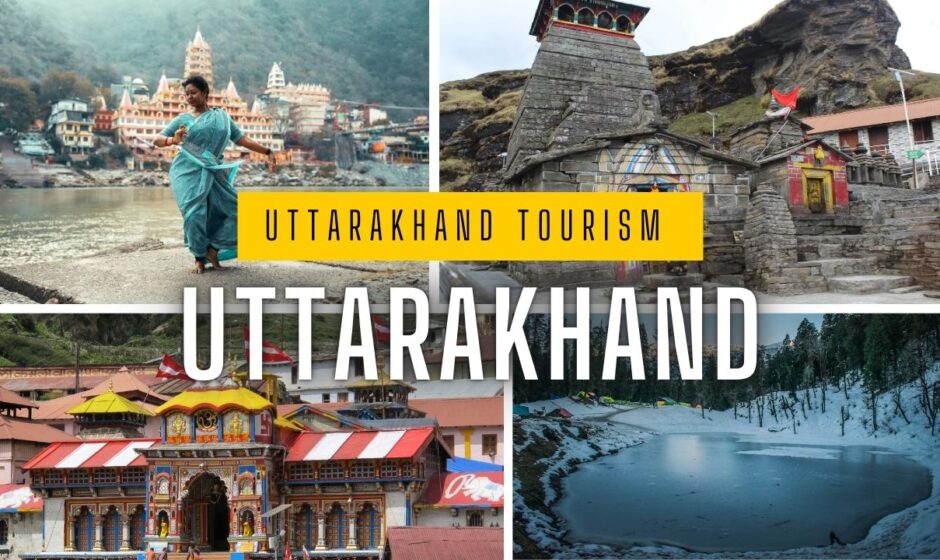Welcome to Uttarakhand Tourism: A Journey Beyond the Surface
Uttarakhand Tourism offers more than just places to visit—it brings together history, local traditions, raw landscapes, and a sense of peace that’s hard to put into words. Nestled in northern India, this Himalayan state is often called “Dev Bhoomi,” or the land of gods, due to its deep-rooted spiritual heritage and temples that go back centuries. But Uttarakhand is not just for pilgrims. It attracts families, solo travelers, adventure lovers, and those who just need a break from city chaos.
In this guide, we’ll walk you through everything that makes Uttarakhand Tourism a compelling choice—from religious significance to hidden mountain villages, and from untamed forests to local food that warms the soul.
The Spiritual Heart of India: Uttarakhand’s Sacred Side
The spiritual foundation of Uttarakhand Tourism is unshakable. Places like Haridwar and Rishikesh form the core of this divine energy. Haridwar is one of the oldest cities in India, known for the Ganga Aarti at Har Ki Pauri—a ritual that has left millions of visitors speechless over generations.
Rishikesh, known as the “Yoga Capital of the World,” brings in global visitors looking for inner balance. Here, yoga is not a retreat—it’s a lifestyle. Countless ashrams and yoga schools line the banks of the Ganges, making it a hotspot for meditation and wellness tourism.
Then there are the Char Dham pilgrimage sites: Yamunotri, Gangotri, Kedarnath, and Badrinath. These temples are located deep in the Himalayas and are central to the spiritual map of India. Each year, thousands of pilgrims make the long, often difficult journey not for comfort, but for faith.
Raw and Rugged: The Mountains That Call You In
Uttarakhand Tourism doesn’t need to depend on polished brochures. The terrain does the talking. This region is home to some of the most challenging and rewarding treks in the country.
The Valley of Flowers trek in Chamoli is a visual celebration—an untouched alpine meadow that blooms with rare Himalayan flora during monsoon. The Roopkund Trek is another highlight, drawing attention with its mystery lake surrounded by human skeletons. For those with experience, the Nanda Devi Base Camp trek offers views that stay in your memory long after the journey ends.
The higher reaches of Uttarakhand also include places like Munsiyari, Chopta, and Auli—less crowded than mainstream hill stations and still brimming with raw, untamed charm.
Forest Trails and Quiet Wildlife Sanctuaries
One of the underrated aspects of Uttarakhand Tourism is its connection with the natural world. The forests here are not just green—they’re alive.
Jim Corbett National Park is the oldest national park in India and remains one of the best places to witness the majestic Bengal tiger in its habitat. But it’s not all about the tiger. Elephants, leopards, gharials, and over 600 bird species also find home here.
Binsar Wildlife Sanctuary, located near Almora, is quieter but just as enchanting. It offers panoramic views of Himalayan peaks like Nanda Devi and Trishul, and the dense oak and rhododendron forests provide a peaceful escape.
For bird lovers, Pangot and Sattal are names that keep popping up. These sleepy hill hamlets near Nainital are ideal for spotting exotic Himalayan birds, especially during early morning walks.
Living Culture and Himalayan Hospitality
The real soul of Uttarakhand Tourism lives in its villages. Time moves differently here. Villages like Mana, the last Indian village before the Tibetan border, show how communities survive in harmony with nature.
In places like Kausani and Almora, homes are still built from mud and stone, and kitchens still serve millet roti with local ghee and bhaang chutney. Guests are treated not as customers, but as part of the home.
Fairs and festivals are taken seriously. The Nanda Devi Mela in Almora, Uttarakhand’s largest religious fair, draws massive crowds every year. In smaller towns, local dance, music, and folk stories are still passed down orally during community gatherings.
Handwoven wool shawls, copper utensils, and locally grown herbs and pulses are often sold by village cooperatives—small reminders of the region’s self-sufficiency and pride in tradition.
Small Towns With Big Heartbeats
Some places don’t make it to most travel lists but still add color to Uttarakhand Tourism in a big way. Pithoragarh, for instance, is a lesser-known town but offers views of five major Himalayan peaks from a single ridge. Similarly, Chaukori is a village surrounded by tea gardens and silence.
Ranikhet and Bageshwar are for those who don’t chase mainstream but look for deeper connections. Life here is slow, the air is fresh, and the people greet you with genuine warmth.
Then there’s Lansdowne, a quiet cantonment town still wrapped in colonial charm, where old churches and pine-covered hills become your companions.
Auli: A Snow-Covered Playground
One place that deserves special mention in any Uttarakhand Tourism guide is Auli. Located at over 8,000 feet, it is India’s top skiing destination. During the winter months, it transforms into a white carpet ideal for beginners and professionals alike.
Even if you’re not into skiing, the chair lift rides and snow-covered forests make the visit worthwhile. In summer, the area changes character completely—lush meadows, pleasant weather, and distant mountain ranges make it ideal for quiet getaways.
Nearby Joshimath acts as the base for the Auli ropeway and opens the door to other trekking routes and spiritual centers.
Local Cuisine That Tells a Story
Uttarakhand Tourism is also carried by its food—simple, healthy, and made from local ingredients. You won’t find heavy cream-based dishes here. Instead, you’ll get wholesome meals like Aloo Ke Gutke (spiced potatoes), Kafuli (a spinach-based dish), and Gahat ke Paranthe (horse gram stuffed flatbreads).
Beverages include rhododendron juice and Buransh squash, made from native flowers. Desserts like Singori, made of khoya wrapped in a maalu leaf, are both unique and memorable.
Most meals are cooked on wood-fired stoves, and flavors reflect both the harsh climate and the availability of local produce. This is food that warms your belly and tells you where you are without saying a word.
Best Time to Visit Uttarakhand and What to Expect
Each season brings something different to Uttarakhand Tourism.
-
March to June offers warm weather and clear skies, ideal for trekking and temple visits.
-
July to September is monsoon, when the forests are at their greenest but landslides can make travel tricky.
-
October to February is winter—good for snow lovers and those seeking quietude. Higher altitudes may remain inaccessible due to snowfall, but lower regions like Dehradun, Rishikesh, and Nainital are still perfect for a break.
Travelers should prepare for temperature changes and road conditions. It’s smart to carry both woolens and rain protection depending on your route. Always check local advisories, especially if you’re going into high-altitude or forested zones.
Final Thoughts: Why Uttarakhand Tourism Leaves a Mark
Uttarakhand Tourism isn’t about flashy billboards or trending destinations. It’s about the feeling you carry back—the sound of a river flowing behind your lodge, the taste of warm food served with a smile, the silence at the top of a trail, and the old temple bells that ring deep into your bones.
Whether you’re walking barefoot in Haridwar, sipping tea in Kausani, or just watching the sun dip behind the mountains in Munsiyari, one thing becomes clear: this is not a place you visit once and forget. Uttarakhand makes you pause, breathe, and feel part of something much older than you.
The state doesn’t try to impress; it simply invites. And that, perhaps, is the strongest reason why Uttarakhand Tourism continues to draw people back year after year.



